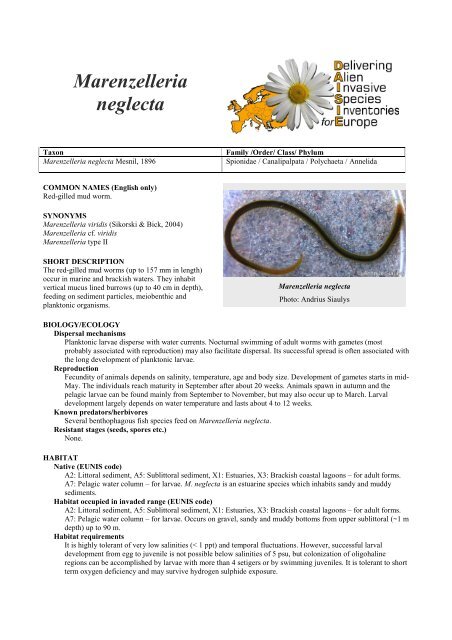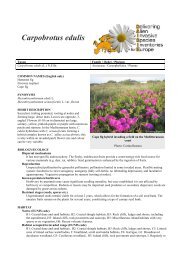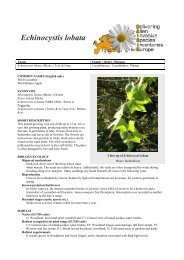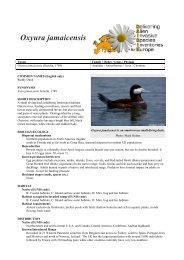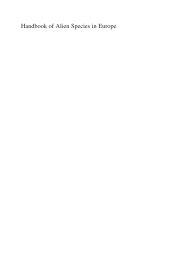Marenzelleria neglecta
Marenzelleria neglecta
Marenzelleria neglecta
Create successful ePaper yourself
Turn your PDF publications into a flip-book with our unique Google optimized e-Paper software.
<strong>Marenzelleria</strong><br />
<strong>neglecta</strong><br />
Taxon Family /Order/ Class/ Phylum<br />
<strong>Marenzelleria</strong> <strong>neglecta</strong> Mesnil, 1896 Spionidae / Canalipalpata / Polychaeta / Annelida<br />
COMMON NAMES (English only)<br />
Red-gilled mud worm.<br />
SYNONYMS<br />
<strong>Marenzelleria</strong> viridis (Sikorski & Bick, 2004)<br />
<strong>Marenzelleria</strong> cf. viridis<br />
<strong>Marenzelleria</strong> type II<br />
SHORT DESCRIPTION<br />
The red-gilled mud worms (up to 157 mm in length)<br />
occur in marine and brackish waters. They inhabit<br />
vertical mucus lined burrows (up to 40 cm in depth),<br />
feeding on sediment particles, meiobenthic and<br />
planktonic organisms.<br />
<strong>Marenzelleria</strong> <strong>neglecta</strong><br />
Photo: Andrius Siaulys<br />
BIOLOGY/ECOLOGY<br />
Dispersal mechanisms<br />
Planktonic larvae disperse with water currents. Nocturnal swimming of adult worms with gametes (most<br />
probably associated with reproduction) may also facilitate dispersal. Its successful spread is often associated with<br />
the long development of planktonic larvae.<br />
Reproduction<br />
Fecundity of animals depends on salinity, temperature, age and body size. Development of gametes starts in mid-<br />
May. The individuals reach maturity in September after about 20 weeks. Animals spawn in autumn and the<br />
pelagic larvae can be found mainly from September to November, but may also occur up to March. Larval<br />
development largely depends on water temperature and lasts about 4 to 12 weeks.<br />
Known predators/herbivores<br />
Several benthophagous fish species feed on <strong>Marenzelleria</strong> <strong>neglecta</strong>.<br />
Resistant stages (seeds, spores etc.)<br />
None.<br />
HABITAT<br />
Native (EUNIS code)<br />
A2: Littoral sediment, A5: Sublittoral sediment, X1: Estuaries, X3: Brackish coastal lagoons – for adult forms.<br />
A7: Pelagic water column – for larvae. M. <strong>neglecta</strong> is an estuarine species which inhabits sandy and muddy<br />
sediments.<br />
Habitat occupied in invaded range (EUNIS code)<br />
A2: Littoral sediment, A5: Sublittoral sediment, X1: Estuaries, X3: Brackish coastal lagoons – for adult forms.<br />
A7: Pelagic water column – for larvae. Occurs on gravel, sandy and muddy bottoms from upper sublittoral (~1 m<br />
depth) up to 90 m.<br />
Habitat requirements<br />
It is highly tolerant of very low salinities (< 1 ppt) and temporal fluctuations. However, successful larval<br />
development from egg to juvenile is not possible below salinities of 5 psu, but colonization of oligohaline<br />
regions can be accomplished by larvae with more than 4 setigers or by swimming juveniles. It is tolerant to short<br />
term oxygen deficiency and may survive hydrogen sulphide exposure.
DISTRIBUTION<br />
Native Range<br />
This northern Hemisphere distributed species has its native range in the Atlantic coast of the North-America.<br />
Known Introduced Range<br />
The first record in the European mainland coast was in the Ems estuary between Germany and the Netherlands<br />
in 1983. In 1985 this species was recorded in the Baltic Sea in German Darss-Zingst Bodden, in subsequent<br />
years it expanded its area throughout nearly the entire Baltic Sea up to inner parts of the Gulf of Bothnia and<br />
Gulf of Finland. Recently it has gradually invaded nearly all north-west European intertidal and estuarine areas.<br />
Trend<br />
Increasing.<br />
MAP (European distribution)<br />
Known in country<br />
Legend<br />
Known in CGRS square<br />
Known in sea<br />
INTRODUCTION PATHWAY<br />
The spread is mostly associated with dispersal and development of planktonic larvae, which can be transported in<br />
ballast waters of ships. Also, adult worms with gametes may get into ballast water during their nocturnal swimming.<br />
IMPACT<br />
Ecosystem Impact<br />
The red-gilled mud worm competes with native benthic macrofauna for food and space. Being numerically<br />
dominant it can change the structure of a native benthic community. Burrowing activity of this worm has a high<br />
impact on fluid-exchange rates between bottom water and sediments, especially in muddy sediments. The<br />
burrow walls make good substrates for aerobic degradation of organic matter.<br />
Health and Social Impact<br />
None.<br />
Economic Impact<br />
Largely unknown. May compete for food with aquaculture organisms.<br />
MANAGEMENT<br />
Prevention<br />
Unknown.
Mechanical<br />
To remove planktonic larvae, exchange of ballast water should take place in the mid ocean. Due to presence of<br />
bottom sediments in ballast tanks, removal of adult worms is complicated.<br />
Chemical<br />
Chemical treatment in ship ballast tanks has been shown to be effective.<br />
Biological<br />
Unknown.<br />
REFERENCES<br />
Daunys D, Zettler ML, Gollasch S (1999) <strong>Marenzelleria</strong> cf. viridis (Verrill, 1873). In: Gollasch S, Minchin D,<br />
Rosenthal H, Voigt M (eds) Case histories on introduced species: their general biology, distribution, range<br />
expansion and impact. Berlin, Logos-Verlag, pp 61-67<br />
Kotta J, Orav H, Sandberg-Kilpi E (2001) Ecological consequence of the introduction of the polychaete<br />
<strong>Marenzelleria</strong> viridis into a shallow water biotope of the northern Baltic Sea. J Sea Res 46: 273-280 .<br />
Zettler M, Daunys D, Kotta J & Bick A. (2002). History and Success of an Invasion into the Baltic Sea: the<br />
Polychaete <strong>Marenzelleria</strong> cf. viridis, Development and Strategies. In: Leppäkoski E, Gollasch S & S. Olenin<br />
(eds). Invasive aquatic species of Europe – distribution, impacts and management. Kluwer Academic Publ.,<br />
Dordrecht, Boston, London, pp 66-77<br />
OTHER REFERENCES<br />
Baltic Sea Alien Species Database (2006) http://www.ku.lt/nemo/mainnemo.html. Cited 01 Oct 2006<br />
Bick A, Burkhardt R (1989) First evidence of <strong>Marenzelleria</strong> viridis Polychaeta (Spionidae) for the Baltic Sea<br />
region, with a sorting key for spionides of the Baltic Sea. Mitt. Zool.Mus. Berl., 65:237-247<br />
Bochert R, Bick A, Zettler M, Arndt E-A (1994) <strong>Marenzelleria</strong> viridis (Verrill, 1873) (Polychaeta, Spionidae), an<br />
invader in the benthic community in Baltic coastal inlets - investigations of reproduction. In: Proceedings of 13th<br />
Symposium Baltic Marine Biologists, Riga, Latvia, Sept 1993.<br />
Essink K, Kleef HL (1988) <strong>Marenzelleria</strong> viridis (Verrill, 1873) (Polychaeta: Spionidae): a new record from the<br />
Ems estuary (The Netherlands/Federal Republic of Germany). Zoologische Bijdragen 38:1-13<br />
Fritzsche D, von Oertzen J-A (1995) Metabolic responses to changing environmental conditions in the brackish<br />
water - polychaetes <strong>Marenzelleria</strong> viridis and Hediste diversicolor. Mar Biol 121:693-699<br />
Maciolek NJ (1984) New records and species of <strong>Marenzelleria</strong> Mesnil and Scolecolepides Ehlers (Polychaeta:<br />
Spionidae) from north-eastern North America. In: Hutchings PA (ed) Proceedings of the first international<br />
Polychaete Conference, Sydney,. The Linnean Society of New South Wales, pp 48-62<br />
Norkko A, Bonsdorff E, Boström C (1993) Observations of the polychaete <strong>Marenzelleria</strong> viridis (Verrill) on a<br />
shallow sandy bottom on the South coast of Finland. Mem Soc Fauna Flora Fennica 69:112-113<br />
Olenin S, Leppäkoski E (1999) Non-native animals in the Baltic Sea: alteration of benthic habitats in coastal inlets<br />
and lagoons. Hydrobiologia 393:233-243<br />
Schiedek D (1993) <strong>Marenzelleria</strong> viridis (Polychaeta). A new species within the benthic communities of coastal<br />
waters: metabolic response to environmental stress. In: Proceedings of 13th Symposium Baltic Marine<br />
Biologists, Riga, Latvia, Sept 1993<br />
Sikorski AV, Bick A (2004) Revision of <strong>Marenzelleria</strong> Mesnil, 1896 (Spionidae, Polychaeta). Sarsia: North Atlantic<br />
Marine Science, 89 (4):253 – 275<br />
Author: Sergej Olenin<br />
Date Last Modified: September, 2006


